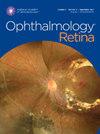Spontaneous Soft Drusen Regression without Atrophy and the Drusen Ooze
IF 5.7
Q1 OPHTHALMOLOGY
引用次数: 0
Abstract
Objective
To determine the incidence of spontaneous soft drusen (SD) regression without atrophy (DRwoA) in patients with intermediate or atrophic age-related macular degeneration (AMD), evaluate associated events, and offer potential explanations.
Design
A retrospective review of the imaging of a consecutive series of 640 eyes from 320 patients with AMD who had ≥2 years of follow-up.
Subjects
Four hundred twenty-seven eyes from 262 patients with intermediate AMD or atrophic AMD and no present or past exudative AMD.
Methods
Retinal imaging included infrared reflectance imaging, fundus autofluorescence, spectral-domain OCT, and color fundus photography.
Main Outcome Measures
The outcomes included drusen regression without atrophy with integrity of the retinal pigment epithelium (RPE) and repositioning over Bruch’s membrane. In addition, drusen that would collapse with atrophy (DCwA) in the same area simultaneously were named “sentinel” DCwA. The outcomes also included the reversibility of features of incomplete RPE, outer retinal atrophy (iRORA), and the areas (“halos”) of DRwoA around the “sentinel” drusen.
Results
Among the 427 eyes, 53 events of DRwoA were found, representing 24.17% of the eyes with SD. In 50 cases (94.33%), a “sentinel” DCwA in the vicinity was found. In 58% of the cases, a well-identifiable halo of drusen disappearance around the “sentinel” DCwA was well visible.
Conclusions
Drusen regression without atrophy is a frequently observed phenomenon linked to SD and almost invariably occurs near a “sentinel” DCwA. The coalescence of the drusen and the spatial and temporal association of the DRwoA and the DCwA strongly suggest that the drusen material of DRwoA escapes to a contiguous “sentinel” DCwA. Although the hypothesis of the disappearance of drusen material due to RPE death may explain the DCwA, it fails to account for DRwoA. Instead, the “drusen ooze” hypothesis, which posits the movement of drusen content to the subretinal space through RPE defects, may explain both the DCwA and the DRwoA. This hypothesis offers insights into the reversibility of iRORA features and suggests that therapies targeting drusen material removal before RPE disruptions could potentially prevent atrophy secondary to SD collapse.
Financial Disclosure(s)
Proprietary or commercial disclosure may be found in the Footnotes and Disclosures at the end of this article.
自发性软性水肿消退无萎缩及水肿渗出。
目标或目的:确定中度或萎缩性年龄相关性黄斑变性(iAMD、aAMD)患者自发性软性色素消退但不萎缩(DRwoA)的发生率,评估相关事件并提供可能的解释:设计:对至少随访 2 年的 320 名老年性黄斑变性患者的 640 只眼睛的连续系列成像进行回顾性审查:262名iAMD或aAMD患者的427只眼睛,这些患者目前或过去没有渗出性AMD:视网膜成像包括红外反射成像(IR)、眼底自动荧光(FAF)、光谱域OCT(SD-OCT)和彩色眼底摄影(CFP):主要结果指标:视网膜色素上皮(RPE)的完整性和布鲁氏膜的复位情况下的无萎缩性色素沉着(DRwoA)。此外,在同一区域同时出现萎缩塌陷(DCwA)的色素被命名为 "哨兵 "DCwA。不完全视网膜色素上皮和视网膜外层萎缩(iRORA)特征的可逆性,以及 "哨点 "色素沉着周围的 DRwoA 区域("光晕"):在 427 只眼睛中,发现了 53 个 DRwoA 事件,占软核眼睛的 24.17%。在 50 个病例(94.33%)中,在其周围发现了 "哨点 "DCwA。在 58% 的病例中,"哨点 "DCwA 周围可以清楚地看到可识别的色素消失光环:DRwoA是一种经常观察到的与软性色素有关的现象,几乎总是发生在 "哨点 "DCwA附近。DRwoA和DCwA在时间和空间上的联系有力地表明,DRwoA的绒毛物质逃逸到了连续的 "哨点 "DCwA上。虽然由于 RPE 死 亡导致色素物质消失的假说可以解释 DCwA,但却无法解释 DRwoA。相反,"色素渗出 "假说认为色素内容物通过 RPE 缺陷向视网膜下空间移动,可以解释 DCwA 和 DRwoA。这一假说为 iRORA 特征的可逆性提供了见解,并表明在 RPE 破坏之前清除色素物质的疗法有可能防止软性色素塌陷引起的继发性萎缩。
本文章由计算机程序翻译,如有差异,请以英文原文为准。
求助全文
约1分钟内获得全文
求助全文

 求助内容:
求助内容: 应助结果提醒方式:
应助结果提醒方式:


